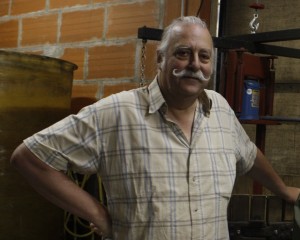
Eddy Oosterlinck
When the magnificently mustachioed hardware merchant, Eddy Oosterlinck-Bracke, and his wife, Mileine, moved from Belgium to buy a small farmhouse in the Coteaux du Layon of the Loire Valley in 1985, they had no intention of making wine anything more than a hobby. It didn’t take long before they caught the bug, and over the course of 15 years, they converted their vineyards to organic farming and expanded their holdings from a few vineyard rows to 6 hectares of land. In 2007, they started to work with biodynamics as well. But these late-in-life vignerons have also brought the wisdom of their years and a good spoonful of skepticism to their new-found path. Although they have adopted these strict farming practices after testing the results on their vines, they still treat the organic movement with some apprehension. For Eddy, it’s not about the hype—it’s about simply making the best of what his terroir has to give.
Domaine de Juchepie is named for a small, south-facing slope in Faye—the heart of the rolling plateau of Layon—situated on schist and volcanic bedrock. In an area known for its elegant, sweet, botrytized Chenin Blanc, the Oosterlincks have also noted a fair share of hypocrisy in the appellation laws, which tend to encourage chaptalization instead of letting Mother Nature do the work. Given the natural conditions of the microclimate and soil, they may make both dry and sweet wines depending on the vintage, but they refuse to add sugar to make their wine more appealing to the AOC. On most of their parcels, including a rare vineyard planted post-phylloxera in 1890, this translates to extremely low yields—as low as a shocking 5 to 10 hectoliters per hectare in some years. There is little doubt that the Oosterlincks are more dedicated to quality than the promise of extra money they could make from the appellation’s standard crop of 35 hl/ha.
In ideal vintages, the Oosterlincks take advantage of botrytis to concentrate the sugars, and in the occasional non-botrytis years, they use the process of passerillage. Incorporating traditional methods with some modern winemaking techniques, they aim for slow pressings (up to 24 hours) on a vertical press, long vinifications, minimal doses of sulfur, and 12-18 months of barrel aging before release. Eddy believes a wine of noble rot should be both sweet and bitter, which is why his wines display an unusual balance, bright minerality and seamless buoyancy that makes them delicious with more than just the traditional foie gras, but also with a variety of game birds and savory dishes.
